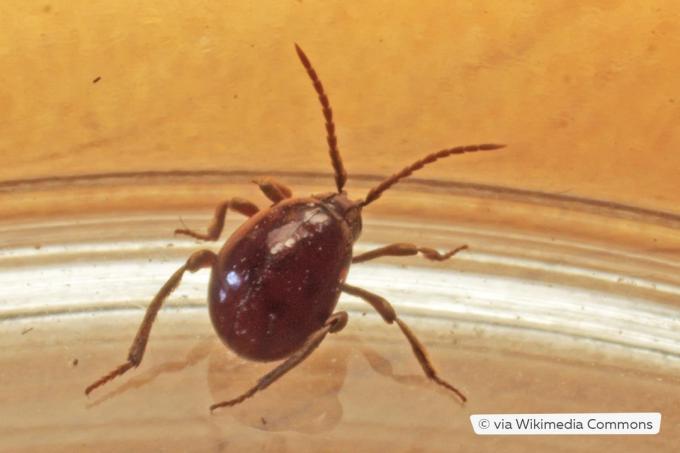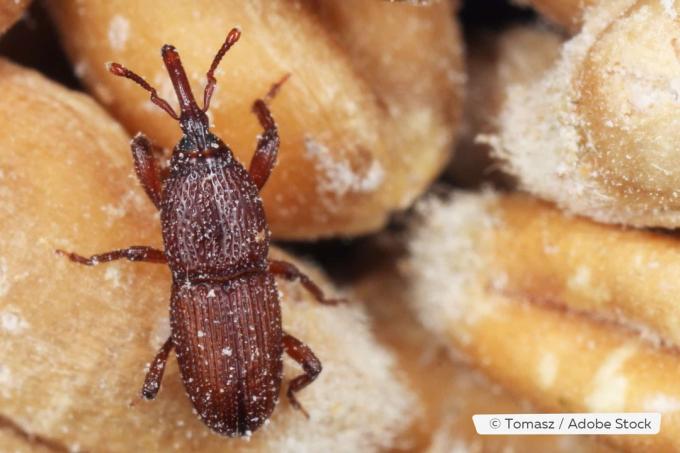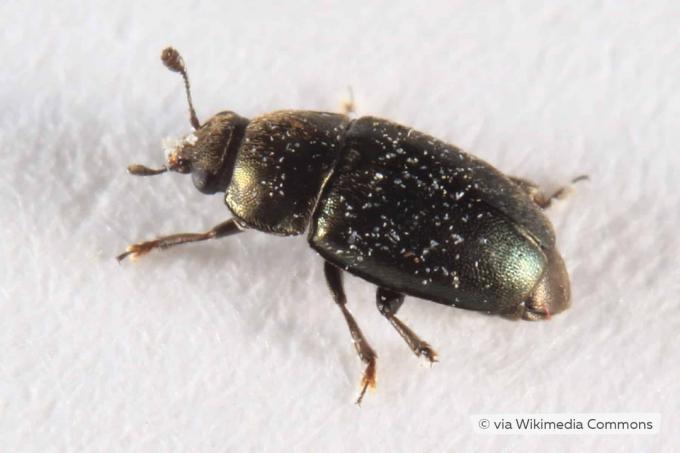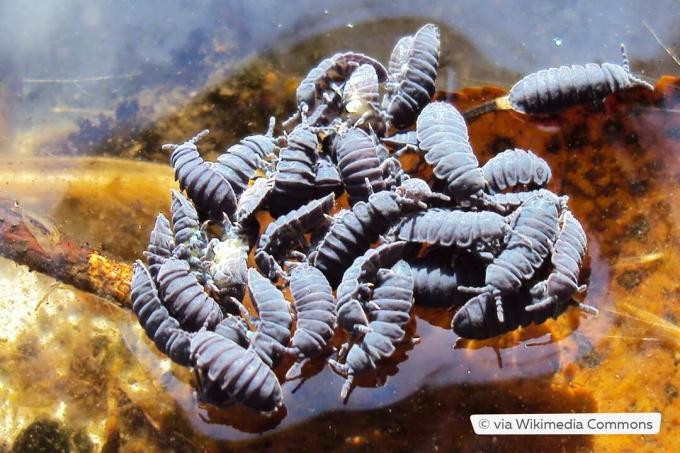
If a small black "dot" wanders around the house or garden, the eye has to take a closer look. It could be a mini bug. Some species are harmless, others cause damage. Introducing tiny little black bugs.
In a nutshell
- in the house: bread beetles, hump beetles, spherical beetles
- Control necessary as material and storage pests
- outdoors: flea beetle, pollen beetle
- small infestations are mostly harmless, fight larger infestations naturally
Table of contents
- bread beetle
- humpback beetle
- flea beetle
- grain weevil
- pollen beetle
- Black diver
- frequently asked Questions
bread beetle

Shopbread beetles (Stegobium paniceum) can be found indoors all year round. The insects fly in through open windows or are brought in unintentionally and unnoticed via supermarket purchases. They lay their eggs in food and can also penetrate unopened packaging.
- Distinguishing features: reddish brown rather than black, rounded-oval body, can fly
- size: max. 3mm tall
- Control: dispose of infested food, wipe cupboards with vinegar water
Tip: Store dry foods in tightly sealed containers. Check your supplies regularly for thick white larvae and webs.
humpback beetle

Due to its body shape, the humpback beetle (Gibbium psylloides) is also known as the "spherical beetle". It is not directly related to the true spherical beetle. The humpback beetle often lives in old buildings and half-timbered buildings, preferably in dark and damp corners. It is regarded as a material and stored product pest and can damage supporting wood, among other things. Since the small black beetles are nocturnal, they can live undetected in the house for a long time.
- Identifying features: reminiscent of spiders, spherical, shiny smooth elytra, legs and abdomen densely hairy, unable to fly
- Size: between 1.9 and 3.4 mm in size
- Control: small infestation with home remedies such as sticky traps, large infestation with exterminators
A notice: Even if some of the beetles presented here appear rather brownish when you look very closely, they are only recognizable as small dark dots at first glance.
flea beetle

Flea beetles (alticini) are garden dwellers that act as plant pests. However, it can happen that individual specimens get lost in the house. Don't worry, they don't lay eggs indoors and do no other harm. Rather, they are trying to find a way out.
- Identifying features: oval, shiny metallic, head area mostly brownish, can jump far
- Size: between 2 and 4 mm in size, but some species are significantly smaller (1 mm)
- Control: only in the garden, for example with tansy broth
grain weevil

The grain weevil (Sitophilus granarius) is a storage pest that is up to mischief in the kitchen or pantry all year round. The menu of the tiny black beetle includes various grains, but also pasta and dried vegetables.
- Distinguishing features: elongated body with grooves and dots, long trunk, powerful mouthpart, unable to fly
- Size: 2 to 4mm
- Control: dispose of infested food, clean thoroughly, spread silica
pollen beetle

The pollen beetle (Brassicogethes aeneus) flies from March to June. The tiny little black beetle loves cruciferous plants, especially oilseed rape, which is why it is regularly fought against in agriculture. But he is also on yellow flowers like dandelion or coltsfoot to meet
- Identifying features: oval, shiny metallic, hairy elytra, thickened filler ends
- size: max. 2mm tall
- Control: collect, beneficials such as parasitic wasps and encourage ladybugs, prevent with good plant care
Tip: If you have spotted this pest in the garden, the first thing you should do is examine your roses more closely. Pollen beetles like white and yellow ones rose petals. Since they are black themselves, you will certainly quickly spot any infestation.
Black diver

At a cursory glance, the black water skipper (Podura aquatica) actually looks like a tiny little black beetle. But he comes from the family of springtails (Collembola). The small animals can be found in the garden mainly on water surfaces, for example in the garden pond or pool. From spring to autumn they can occur in such large numbers that the water surface looks black.
- Distinguishing features: forked tail appendage, can jump several centimeters above the water
- Size: only 1 to 1.5 mm in size
- Control: Purification of the water/deprivation of the basic nutrients algae and bacteria
frequently asked Questions
Chances are you're not dealing with bugs, you're dealing with bed bugs to do. At first glance, they can easily be mistaken for beetles. Take a closer look. If the suspicion should be confirmed, you must do something immediately.
No, Don `t worry. The little beetles cannot bite through human skin with their mouthparts.
No, the beetle species living in this country are not poisonous.
It is usually harmless to pick up small beetles by hand. Still, it's safer to catch them without direct contact, wear gloves, or at least wash your hands thoroughly afterwards.
